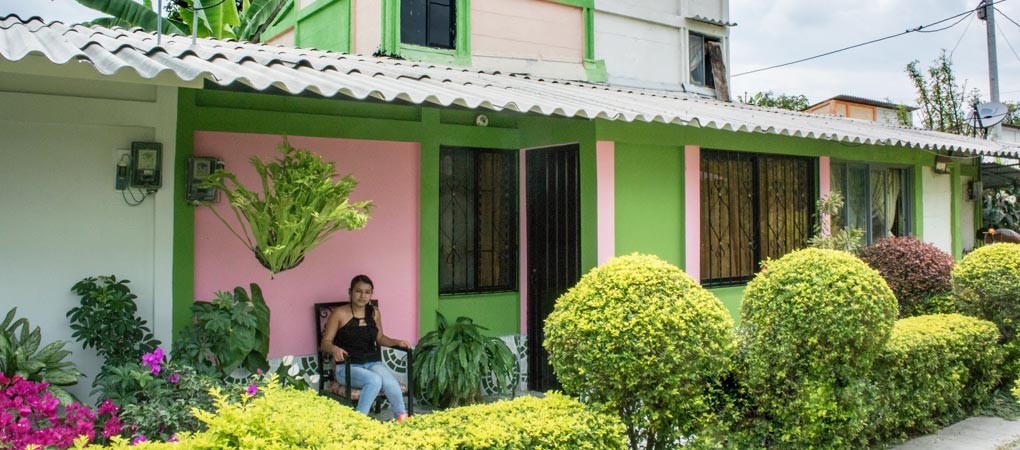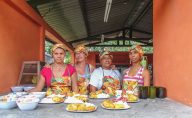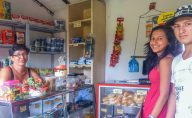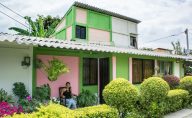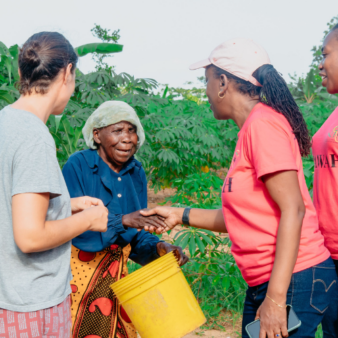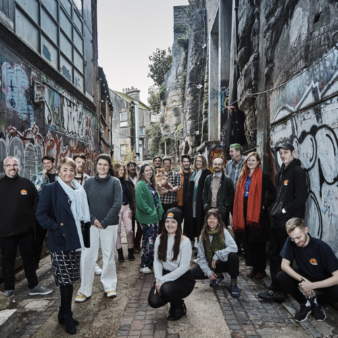Nashira Un Canto de Amor (a song of love) is an eco-village in rural Colombia built for and by women who have suffered displacement as a result of Colombia’s fifty year civil war and/or domestic violence.
Project Description
Aims and Objectives
- The project offers a safe, permanent and affordable housing solution for women who have been displaced or subject to sexual or domestic violence.
- It minimises costs (houses cost approximately US$10,000 each to build) enabling houses to be offered rent free; enabling women to escape from poverty.
- It aims to empower women. The village is run by a series of committees and production centres are all chaired and run by women from the village.
- It creates employment opportunities by establishing workshops where women can manufacture their own products. The income achieved through the sale of these products can further help them escape poverty.
- The village provides a secure and nutritious supply of food grown on its own land and has its own clean water supply.
Nashira is an eco-village of 88 homes in Southern Colombia. It was built for and by women who suffered domestic violence or who have been displaced by the Colombian civil war. The project is funded by the Government’s Rural Housing subsidy.
Costs are kept to a minimum by using sweat equity and low cost or free recycled materials. These savings enable the ownership of the houses to be obtained without any costs as they don’t have a deposit or mortgage, they are free. As they are houses which have been developed by the community, they are family assets which cannot be seized so the houses cannot be lost as a result of debts. The project enables women to set up productive task teams that allow them to earn a regular income. There are task teams dealing with organic food production, a Saturday market, a restaurant and rooms within the houses for homestay tourism.
The project is a model of how different ways of living together can make a community more resilient, both ecologically and socially. The project offers a secure supply of organic food grown on its own land. Water and waste are managed in low-cost and ecologically sustainable ways. Reedbeds are used to filter the water, an aqueduct brings water to the village and waste is either recycled or composted.
The project was set up by the Nashira Women’s Association for a Better Quality of Life (Asociación de Mujeres Nashira por Mejor Calidad de Vida) (Nashira) through the purchase of 3.3 hectares of land that had previously been a banana plantation. The purchase costs were met by a donation from the Douglas Dolmetsch Foundation.
Context
Colombia is a country that has been locked in a civil war for fifty years. Since the mid-1960s, the country has suffered from a complex low intensity conflict between the government, paramilitaries’ and guerrilla groups. Over 220,000 people have been killed and according to UNHCR nearly six million people have been forced out of their homes. This has created the largest number of internally displaced people of any country in the world apart from Syria. In addition to this, the drugs trade has displaced thousands of people as drug producers attempt to expand their cultivation of coca into remote farmland areas.
The effects of this have been highly damaging to individuals and families. There is widespread evidence of sexual violence against women and many families have been broken up. The majority of displaced people are women. Thirty per cent of women in Colombia are single mothers and 35 per cent of children live in single parent families. Seventy per cent of single parent families are below the poverty line.
Key Features
Women build their own houses. They are expected to contribute at least 1,200 hours in total towards construction.
Houses are constructed from recycled materials in innovative ways. For example, walls are constructed with walls made out of rubbish and some are of plastic drinks bottles filled with soil. Stairs are made from used car tyres and windows are made from recycled glass bottles.
Homes are provided rent-free.
The project provides clean drinking water. This was a particular challenge as the local ground water is contaminated. A large aqueduct brings in fresh water from a nearby spring.
There are eleven production centres, which create income for the village. These include: homestay for tourists in spare bedrooms; waste recycling; small scale market gardening producing fruit and vegetables; fish farming and ceramic production.
Nashira operates its own currency for financial transactions in the village. This helps keep the income generated within the village.
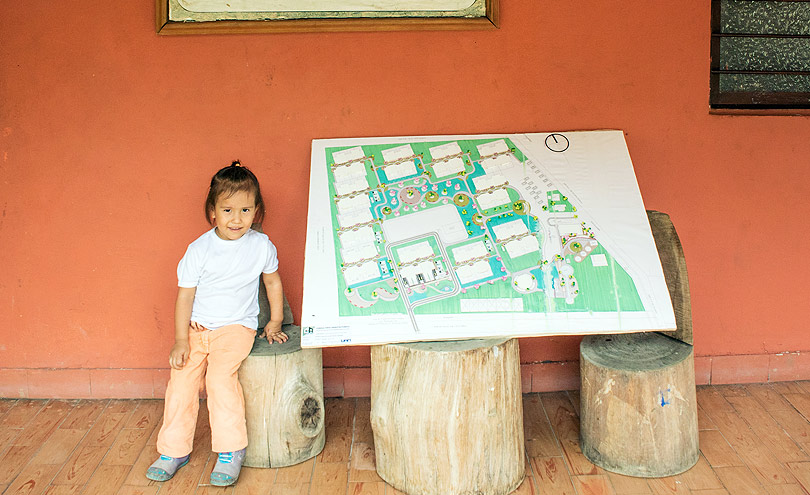
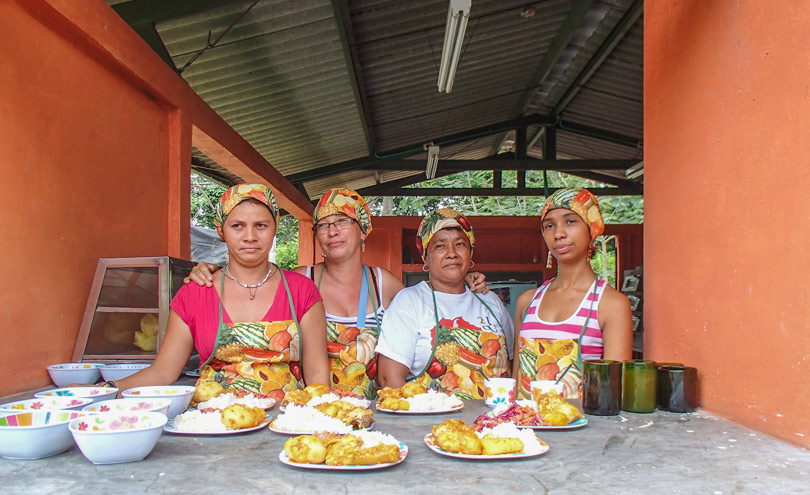
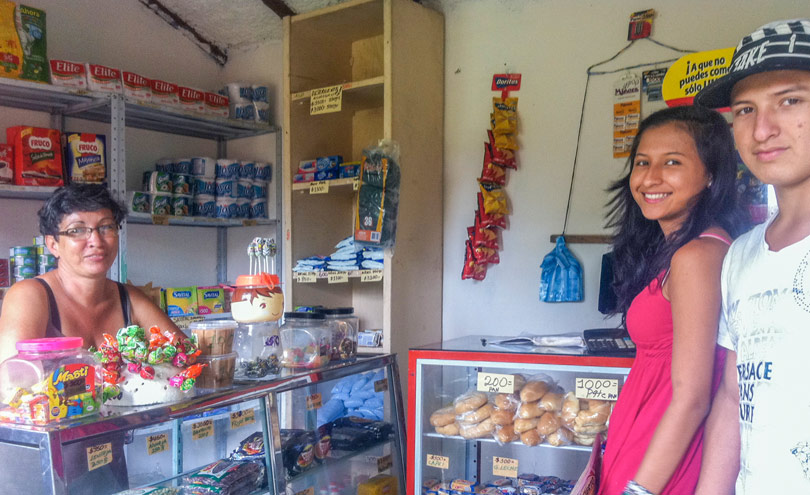
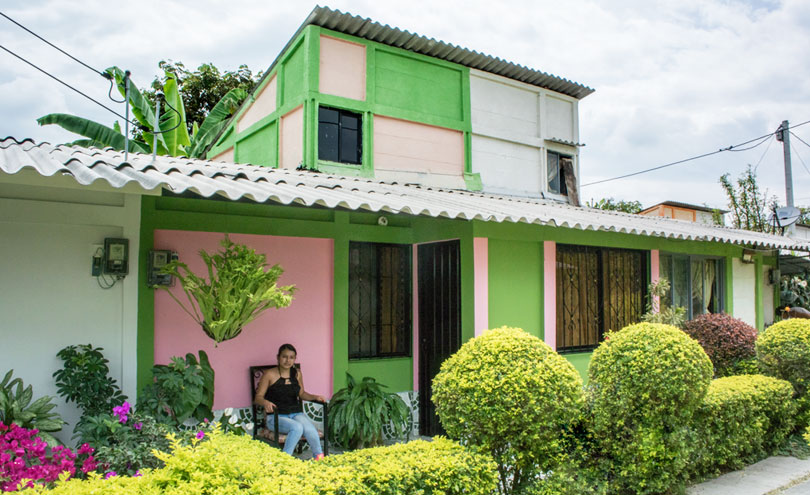
What impact has it had?
The village has achieved its aims through the successful self-build of houses and the communal facilities in the village.
The quality of life of the women in the village has significantly improved. Most women previously lived in poverty in slums in nearby towns. All have been lifted out of poverty and health outcomes have improved significantly.
The village is close to being financially self-sufficient.
How is it funded?
The project was established with a grant from the Douglas Dolmetsch Foundation. Other set up costs were provided by the Colombian Government Social Housing Programme. Donations and grants have also been provided by the United States Agency for International Development (USAID) and the water company Aquavalle. In the early stages the government charged women 10 per cent of the costs of building the houses. This was a condition of the government grant. The village has negotiated a change whereby in-kind costs are counted as a financial contribution by the government. This has allowed the charge to be dropped.
The village aims to be self-sufficient in its running costs. It has created a number of income generating activities called production centres. Many of these provide personal income for the women who live in the village and others help provide operating costs for the village’s communal facilities.
Why is it innovative?
- Nashira has demonstrated that an eco-village can operate as a viable and self-sufficient concern. It also demonstrated that eco–living is not necessarily only a life-style choice for high income earners but an effective way of helping people out of poverty.
- Nashira has led the way in providing women-centred housing where the women are in control. This approach is new to Colombia.
- The building techniques make use of very low cost materials and use what would otherwise be waste.
What is the environmental impact?
The village is highly sustainable environmentally. It creates little if any waste, consumes little energy and creates few pollutants. Carbon emissions, although not measured, are likely to be very low.
Is it financially sustainable?
The village is close to being financially self-sufficient. Operating costs are covered by income generating activities. The village has achieved its aim of doing so without charging rent. The village does not appear to have large reserves and so any significant improvements and changes to the village have fundraising implications.
What is the social impact?
The project succeeded in improving the living conditions and quality of life for women who had suffered domestic violence or been displaced by the Colombian civil war.
Barriers
- At the start of the project, women were expected to pay 10 per cent of the upfront cost to build the houses. This was a government subsidy condition. Many were not able to cover this. When women started contributing to the actual construction of the houses the upfront cost was removed.
- There has been some opposition from local men and from relatives who did not want women to be the homeowners.
- Some of the income generating businesses proved not to be viable and have failed.
Lessons Learned
- An eco-village is not just an idealistic notion but a viable way of living. It can successfully be used to lift people out of poverty.
- Living rent-free is a key way of helping people out of poverty. Without the need to make regular rent or mortgage payments, women were better able to improve their lives.
- Although the village was set up for women, from the beginning it proved sensible to include some male relatives, such as long-term partners, who remained heads of households. However, as some of the women were abandoned or mistreated, some men had to be excluded from the village which left the women as the sole heads of households even though men are still welcome. This showed that the Nashira approach worked.
Evaluation
An ongoing feature of the project over its 13 years has been the link with academia which has led to the formation of a research group which evaluates and monitors every stage of the project. Amongst the organisations most closely involved are the University of Valle and its environmental, urbanism, gender, sociology and solidarity economy programmes. The community psychology programmes of the Cooperative University and the environmental programmes of the National University are also involved. Several postgraduate theses have been written, which analyse and evaluate the programme as a whole.
Transfer
Within Colombia seven other eco villages for women have been set up.
UN Habitat has initiated a project in Santa Marta using some elements of Nashira.
Internationally, UN Habitat is helping to set up Nashira- inspired projects in Mexico and El Salvador.

